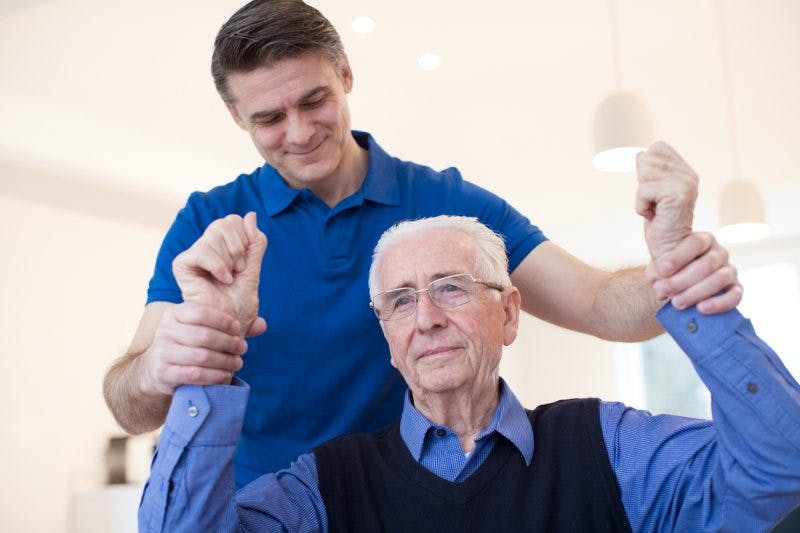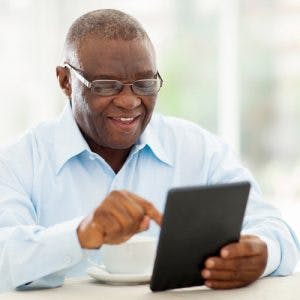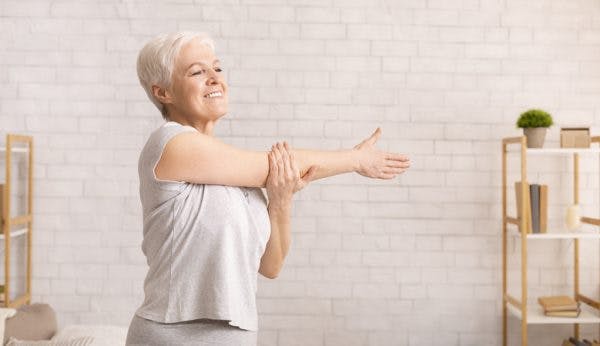Flaccidity after stroke is a common secondary effect and is often present in the early days of stroke rehabilitation. Flaccidity refers to a complete lack of voluntary movement in a limb and is caused by damage to the neural pathways between the brain and muscles.
In some cases, flaccidity can resolve itself quickly with minimal intervention. In more severe cases, however, flaccidity can be persistent and can give rise to other secondary effects or complications. To help you better understand this stroke effect, this article will review the causes of flaccidity and appropriate treatment, including therapy management.
What is Flaccidity After Stroke?
Flaccidity (also known as flaccid paralysis) after stroke occurs as a result of interrupted communication within the nervous system. This often accompanies hemiparesis or hemiplegia, which refer to weakness or paralysis of one side of the body. Flaccidity corresponds to the first stage in the Brunnstrom Stages of Stroke Recovery and generally occurs following more severe strokes.
After a stroke, the neural connections between the brain and the muscles can be compromised due to damage to specific areas of brain tissue. Depending on the areas of the brain affected, this can result in a wide variety of secondary effects or affected daily functions.
More specifically, when a stroke causes damage in areas of the brain responsible for voluntary (intentional) movement, signals between the brain and muscles are interrupted. Therefore, the messages the brain normally sends to the muscles can no longer get through, leaving the muscles effectively paralyzed.
When a person has flaccid paralysis, they cannot initiate any voluntary movement on their affected side. This means the affected limb is not able to move on its own and generally hangs loosely due to this lack of muscle function. Furthermore, flaccidity of the left side after stroke can be accompanied by a general lack of awareness of that side, known as left neglect.
For some stroke survivors, the flaccidity stage is the initial period immediately following a stroke. However, not all stroke survivors will demonstrate complete flaccidity even immediately after their stroke. Since every stroke is unique, some survivors may also present with flaccidity that lasts beyond the initial period after stroke.
If flaccidity lasts too long without treatment, the muscles can begin to atrophy, or decrease in size. This is due to decreased muscle activity in the affected limb as well as learned nonuse and compensation techniques. Flaccidity is also often associated with low muscle tone (hypotonia) after stroke.
Hypotonia and Flaccidity
Hypotonia refers to low muscle tone that can occur because of an injury to the brain, such as a stroke. Muscles that are functioning normally will have a small amount of contraction even when they’re relaxed, which helps maintain muscle tone and good positioning. This constant tension does not occur with hypotonia, however, and leads to decreased muscle tone overall.
Low muscle tone often co-exists with muscle weakness and numbness, increasing a person’s risk of injury to the affected body parts. This is why early intervention is important to help kickstart the recovery process before hypotonia worsens or flaccidity leads to additional complications.
How Long Does Flaccidity After Stroke Last?
Every stroke is different, so it is difficult to predict how long flaccidity will last for each individual. Some cases of flaccidity will fade after a few days as the brain begins to heal and move into a less acute stage of recovery. However, flaccidity after stroke is a severe motor (movement) impairment that can last weeks to years following the initial injury.
In one study, 38% of patients were able to recover some dexterity in the flaccid arm in 6 months and 11.6% saw a complete recovery of function during this time. This is because the brain has the ability to rewire itself through a process called neuroplasticity. With appropriate treatment, it is possible to encourage the brain to re-establish its connection to the muscles and overcome flaccidity after stroke.
Treatments for Flaccid Paralysis
As we discussed in the previous section, neuroplasticity refers to the brain’s ability to rewire neural pathways. These new pathways allow unaffected areas of the brain to take control of functions from areas affected by the stroke. Through this process, survivors can recover functions that were previously lost, including regaining muscle activation to reduce flaccidity after stroke.
Normally, the most effective way to activate neuroplasticity is through intensive rehab exercise. This can be difficult, however, when a limb is affected by flaccid paralysis. Fortunately, there are still ways to engage neuroplasticity even when you can’t move your muscles actively.
The following are effective ways to promote neuroplasticity and help treat flaccidity and other secondary effects of stroke:
1. Passive Range of Motion
When an exercise cannot be performed actively, passive exercises can help you maintain range of motion and encourage muscle function. During passive exercises, a therapist or caregiver moves your muscles for you, or you move them yourself using your unaffected limb.
Even though you technically aren’t activating the muscles, engaging them in passive motion can stimulate the brain and rekindle the neural networks that help you move. Additionally, these exercises will help to keep your joints mobile while your arm is in the flaccid state. This can help you avoid additional complications such as contractures after stroke.
Have your physical or occupational therapist show you the correct movements before trying them at home. This can help you avoid moving your affected limb into painful or non-optimal positions.
See all passive ROM exercises »
2. Mirror Therapy
Another technique to help engage neuroplasticity in the absence of active muscle control is mirror therapy. Mirror therapy utilizes a tabletop mirror or mirror box to create a reflection of the participant’s unaffected arm or hand.
To practice this therapy, place your unaffected limb outside the mirror box and your flaccid arm inside the box. Next, start doing hand therapy exercises with your non-paralyzed hand while focusing your vision on the reflection in the mirror. When you look at the box, you will see the reflection of your good hand moving in the place where your flaccid arm should be.
This simulated visual feedback activates mirror neurons in the premotor cortex, the part of the brain that controls movement. In other words, mirror therapy can help “trick” the brain into thinking the affected limb is performing a task or movement, which in turn activates neuroplasticity.
Learn more about mirror therapy for stroke paralysis recovery »
3. Electrical Stimulation
Electrical stimulation is another excellent way to address flaccidity after stroke as it can encourage communication between the brain and muscles. Electrical stimulation, also called e-stim, works by sending an electrical impulse directly to your affected muscles, causing them to contract.
Studies have shown that e-stim can actually prime the motor cortex and make neuroplasticity more effective. For this reason, electrical stimulation can be used for patients experiencing a wide variety of symptoms such as flaccidity or foot drop after stroke.
Electrical stimulation is most effective when combined with rehab exercise, even if this exercise is passive. This combination of e-stim and exercise, called functional electrical stimulation (FES), has been shown to be effective in improving function for stroke patients with upper limb dysfunction or flaccidity. The more you stimulate your brain and muscles, the more you can encourage the rewiring of important neural pathways.
Other effective ways to stimulate your muscles during rehab exercise include tapping the muscles you want to activate and performing quick stretches. Have your therapist show you how to engage in e-stim, muscle tapping, and quick stretching to make sure you are using these techniques safely and properly.
Learn more about electrical stimulation for stroke rehab »
4. Mental Practice
Along with passive exercise, mental practice is another valuable tool to improve outcomes for those affected by flaccidity after stroke. Mental practice for stroke patients involves visualizing yourself moving your flaccid muscles, which can help promote neuroplasticity.
Several studies have shown that mental practice engages the same brain regions as physical movement. This, therefore, makes mental practice a great way to reconnect your mind to your muscles and overcome flaccidity after stroke. Additionally, research suggests that mental practice can also have a positive impact on performance of daily functions.
Mental practice is a technique you can easily practice at home in combination with your rehab exercises. While you or your caregiver move your affected arm or leg, watch the limb move and imagine you are moving it yourself. Combining mental practice with passive range of motion exercises can help boost neuroplasticity and facilitate the return of muscle function.
Learn more about mental practice for stroke recovery »
5. Active Exercise
Staying consistent with your rehabilitation program can help boost your recovery from flaccidity after stroke. Exercise helps improve neural connections between your brain and muscles, and you may begin to notice muscle twitching or other signs of recovery after stroke.
Due to neuroplasticity, you may be able to regain some movement in your affected limb as neural pathways and connections improve. For example, you may start to see twitches in your arm or hand. When this occurs, you’ll want to take immediate advantage and continue to progress your rehab exercises to involve more active, or voluntary, motions.
Even if you can only move a few centimeters at a time, it is vital to perform massed practice of active exercises to reinforce these neural connections. Over time your muscles can become stronger and these motions will begin to take place more automatically. Additionally, some individuals may experience spontaneous recovery of muscle function due to the brain’s natural healing process.
To start incorporating active exercise into your routine, you can continue with your passive exercises but focus on using your affected limb to help you complete the motion. As you progress, you may need less assistance to move your limb as your muscles regain strength and coordination.
One of the best ways to accomplish high repetition of rehab exercises is to use FitMi home therapy. This device helps patients engage their entire body, including their hands, arms, and core, in dynamic exercise. In fact, FitMi is the reason one patient with flaccidity after stroke was able to move his arm for the first time after only three weeks of exercise.
See all active stroke rehab exercises »
6. Optimal Positioning
For many survivors affected by flaccidity after stroke, regaining movement in the affected limb is their top priority. However, it is important to remember that recovery from flaccidity can be a slow process and a full return of muscle function may not be guaranteed. For this reason, positioning is a valuable part of the rehabilitation process.
When a limb is flaccid after stroke, the muscles that normally maintain optimal positioning for that limb are not functioning correctly. This can lead to increased levels of pain, increased swelling in the limb, and shoulder subluxation.
To help avoid these complications, it is important to work closely with your physical and occupational therapist to prioritize optimal positioning of your flaccid limb. Your therapist can review different positioning techniques for day and night to help reduce pain and tissue strain that sometimes accompanies flaccidity after stroke.
Additionally, your therapy team can recommend splints or specialized slings to help you maintain good positioning of your limb during your recovery. They can also connect you with an orthotist or prosthetist who can fit you with a custom splint or orthosis to maximize your function during daily activities.
Overcoming Flaccidity After Stroke
Flaccidity after stroke affects a large number of survivors and can have a major impact on daily activities and overall independence. For most people, this stage does not last very long and, with time, you should enter the second phase of stroke recovery where flexion synergy patterns occur.
For some survivors, however, flaccidity after stroke can be longer lasting. Thankfully, you can improve your outcome by promoting neuroplasticity via many different rehabilitation techniques.
Passive range of motion, electrical stimulation, and mental practice are some techniques that can jumpstart your recovery. Additionally, these techniques are important to help minimize muscle atrophy and improve neural connections to help recover active muscle function. As you progress, it is also important to prioritize good positioning of your limb to avoid complications.
Above all, it is vital to work closely with your medical and rehab team to help create a plan that will allow you to be as functional as possible and continue working toward recovery. This will help you navigate flaccidity after stroke and can help you regain your independence.










